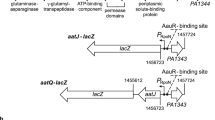Abstract
Evidence for the existence of an energy-dependent urea permease was found for Alcaligenes eutrophus H16 and Klebsiella pneumoniae M5a1 by studying uptake of 14C-urea. Since intracellular urea was metabolized immediately, uptake did not result in formation of an urea pool. Evidence is based on observations that the in vivo urea uptake and in vitro urease activity differ significantly with respect to kinetic parameters, temperature optimum, pH optimum, response towards inhibitors and regulation. The K m for urea uptake was 15–20 times lower (38 μM and 13 μM urea for A. eutrophus and K. pneumoniae, respectively) than the K m of urease for urea (650 μM and 280 μM urea), the activity optimum for A. eutrophus was at pH 6.0 and 35°C for the uptake and pH 9.0 and 65°C for urease. Uptake but not urease activity in both organisms strongly decreased upon addition of inhibitors of energy metabolism, while in K. pneumoniae, potent inhibitors of urease (thiourea and hydroxyurea) did not affect the uptake process. Significant differences in the uptake rates were observed during growth with different nitrogen sources (ammonia, nitrate, urea) or in the absence of a nitrogen source; this suggested that a carrier is involved which is subject to nitrogen control. Some evidence for the presence of an energy-dependent uptake of urea was also obtained in Pseudomonas aeruginosa DSM 50071 and Providencia rettgeri DSM 1131, but not in Proteus vulgaris DSM 30118 and Bacillus pasteurii DSM 33.
Similar content being viewed by others
Abbreviations
- CCCP:
-
Carbonylcyanide-m-chlorphenylhydrazone
- DCCD:
-
dicyclohexylcarbodiimide
- DNP:
-
2,4-dinitrophenole
References
Berger EA, Heppel LA (1974) Different mechanisms of energy coupling for the shock sensitive and shock resistant amino acid permease of Escherichia coli. J Biol Chem 294:7747–7755
Bornside GH, Kallio RE (1956) Urea-hydrolyzing bacilli. II. Nutritional profiles. J Bacteriol 71:655–660
Cooper TG, Sumrada R (1975) Urea transport in Saccharomyces cerevisiae. J Bacteriol 121:571–576
Dunn E, Pateman JA (1972) Urea and thiourea uptake in Aspergillus nidulans. Heredity 29:129
Horrigan SG, McCarthy JJ (1981) Urea uptake by phytoplankton at various stages of nutrient depletion. J Plankt Res 3:403–414
Horrigan SG, McCarthy JJ (1982) Phytoplankton uptake of ammonium and urea during growth on oxidized forms of nitrogen. J. Plankt Res 4:379–389
Jahns T, Kaltwasser H, Kleiner D (1986) Ammonium (methylammonium) uptake by Alcaligenes eutrophus H16. Arch Microbiol 145:306–310
Kaltwasser H, Krämer J, Conger WR (1972) Control of urease formation in certain aerobic bacteria. Arch Mikrobiol 81:178–196
Kleiner D (1985a) Bacterial ammonium transport. FEMS Microbiol Rev 32:87–100
Kleiner D (1985b) Energy expenditure for cyclic retention of NH3/NH +4 during N2 fixation by Klebsiella pneumoniae. FEBS Lett 187:237–239
Leftley JW, Syrett PJ (1973) Urease and ATP:urea amidolyase activity in unicellular algae. J Gen Microbiol 77:109–115
Mackerras AH, Smith GD (1986) Urease activity of the cyanobacterium Anabaena cylindrica. J Gen Microbiol 132:2749–2752
Magaña-Plaza I, Ruiz-Herrera J (1967) Mechanisms of regulation of urease biosynthesis in Proteus rettgeri. J Bacteriol 93:1294–1301
Magasanik B (1982) Genetic control of nitrogen assimilation in bacteria. Annu Rev Genet 16:135–168
Nossal NG, Heppel LA (1966) The release of enzymes by osmotic shock from Escherichia coli in exponential phase. J Biol Chem 241:3055–3062
Pateman JA, Kinghorn JR, Dunn E, Forbes E (1973) Ammonium regulation in Aspergillus nidulans. J. Bacteriol 114:943–950
Pateman JA, Dunn E, Mackay EM (1982) Urea and thiourea transport in Aspergillus nidulans. Biochem Genet 20:777–790
Pengra RM, Wilson PW (1958) Physiology of nitrogen fixation by Aerobacter aerogenes. J Bacteriol 75:21–25
Rees TAV, Syrett PJ (1979) The uptake of urea by the diatom, Phaeodactylum. New Phytol 82:169–178
Rees TAV, Syrett PJ (1984) Proton cotransport of thiourea in Chlorella fusca. FEMS Microbiol Lett 25:17–19
Rees TAV, Cresswell RC, Syrett PJ (1980) Sodium dependent uptake of nitrate and urea by a marine diatom. Biochim Biophys Acta 596:141–144
Ritchie RJ, Gibson J (1987) Permeability of ammonia, methylamine and ethylamine in the cyanobacterium, Synechococcus R-2 (Anacystis nidulans) PCC 792. J Membrane Biol 95:131–142
Roon RJ, Levenberg B (1968) An adenosine triphosphate-dependent avidin-sensitive enzymatic cleavage of urea in yeast and green algae. J Biol Chem 243:5213–5215
Rosenstein IJ, Hamilton-Miller JM, Brumfitt W (1981) Role of urease in the formation of infection stones: comparison of ureases from different sources. Infect Immun 32:32–37
Schlegel HG, Kaltwasser H, Gottschalk G (1961) Ein Submersverfahren zur Kultur wasserstoffoxidierender Bakterien: Wachstumsphysiologische Untersuchungen. Arch Mikrobiol 38:209–222
Schmidt K, Jensen-Liaaen S, Schlegel HG (1963) Die Carotinoide der Thiorhodaceae. I. Okenon als Hauptcarotinoid von Chromatium okenii Perty. Arch Mikrobiol 46:117–126
Sumrada R, Gorski M, Cooper T (1976) Urea transport-defective strains of Saccharomyces cerevisiae. J Bacteriol 125:1048–1056
Syrett PJ, Bekheet IA (1977) The uptake of thiourea by Chlorella. New Phytol 79:291–297
Tien HT (1974) Bilayer lipid membranes. Marcel Dekker, New York
Whitney PA, Cooper TG (1972) Urea carboxylase and allophanate hydrolase. Two components of adenosine triphosphate: urea amidolyase in Saccharomyces cerevisiae. J Biol Chem 247: 1349–1353
Wilde E (1962) Untersuchungen über das Wachstum und Speicherstoffsynthese von Hydrogenomonas. Arch Mikrobiol 43:109–137
Williams II SK, Hodson RC (1977) Transport of urea at low concentrations in Chlamydomonas reinhardii. J Bacteriol 130: 266–273
Zorn C, Dietrich R, Kaltwasser H (1982) Regulation by repression of urease biosynthesis in Proteus rettgeri. Z Allg Mikrobiol 22:199–203
Author information
Authors and Affiliations
Rights and permissions
About this article
Cite this article
Jahns, T., Zobel, A., Kleiner, D. et al. Evidence for carrier-mediated, energy-dependent uptake of urea in some bacteria. Arch. Microbiol. 149, 377–383 (1988). https://doi.org/10.1007/BF00425574
Received:
Accepted:
Issue Date:
DOI: https://doi.org/10.1007/BF00425574




